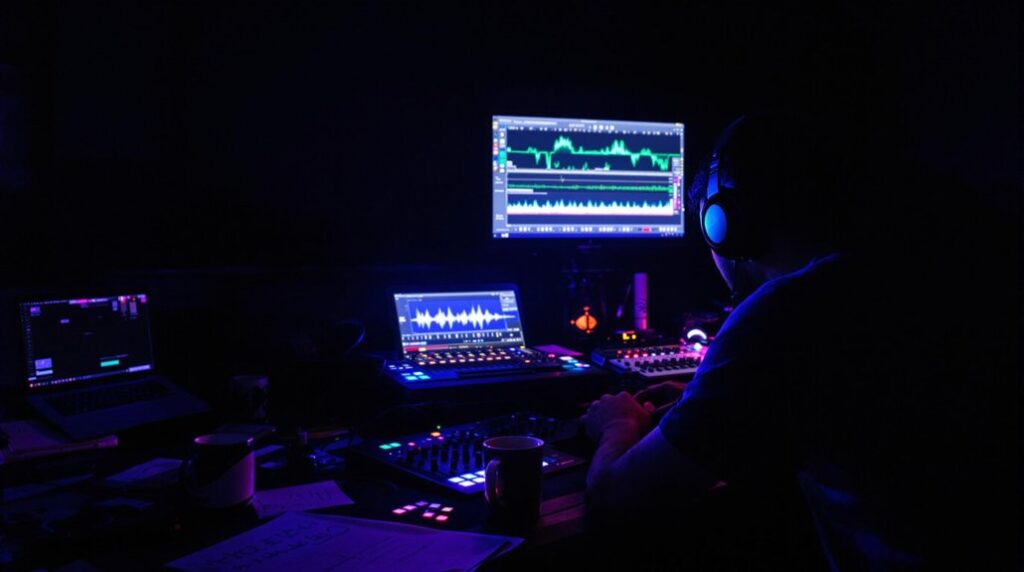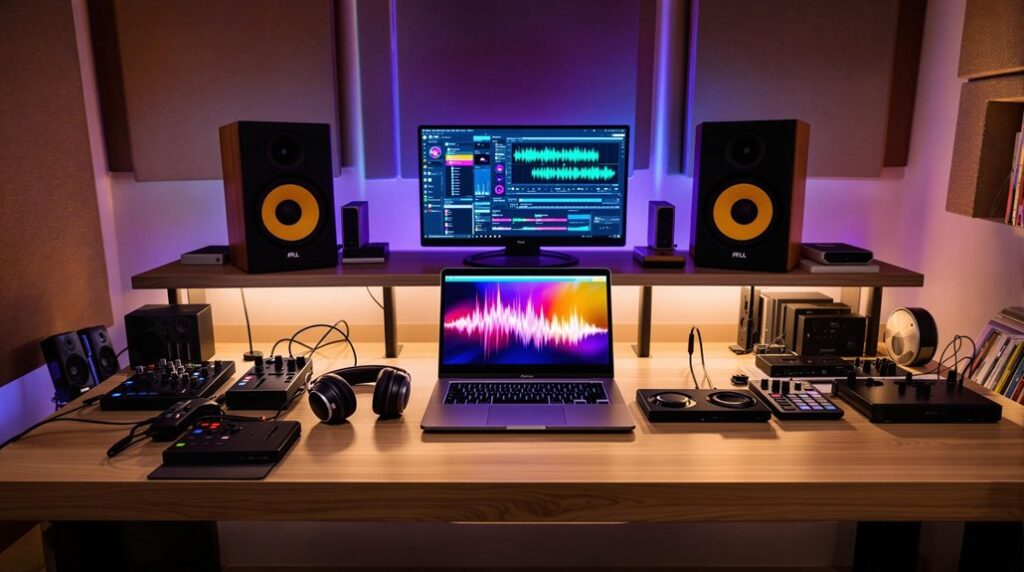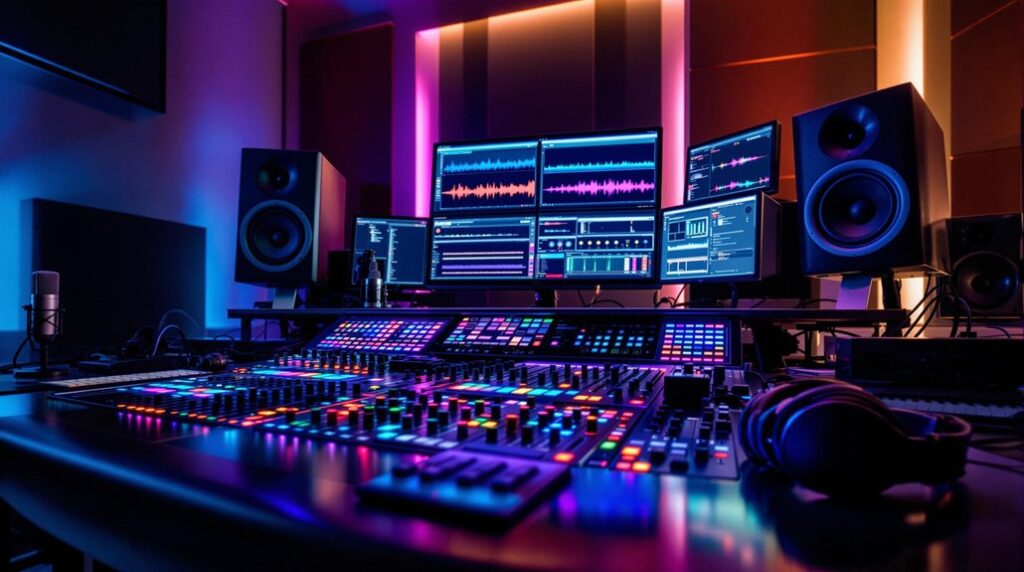Achieving depth and dimension in your mix involves strategic use of EQ, reverb, and panning. Start by balancing the frequency spectrum to avoid masking sounds. Use reverb types like hall or room to create spatial layers, adjusting predelay for perceived distance. Apply dynamic fader automation for volume control and hierarchy establishment. Utilize tempo-synced delays and strategic panning to enhance spatial depth. Avoid over-compression to maintain dynamic range. Experiment with these techniques to create a mix that feels expansive and immersive, leading to a richer auditory experience. Explore each method to reveal the full potential of your mix’s depth.
Key Takeaways
- Utilize a combination of reverb types to create spatial complexity and depth.
- Apply strategic panning to enhance stereo placement and spatial perception.
- Use EQ to carve out frequency ranges for each element, preventing masking.
- Implement delay effects, such as tempo-synced delays, for rhythmic consistency and 3D quality.
- Employ transient shaping to enhance percussive elements and control decay for spatial clarity.
Understanding Frequency Spectrum
To achieve a balanced and professional mix, it’s essential to understand the frequency spectrum, which encompasses the range of audible frequencies from 20 Hz to 20 kHz. Mastery of this spectrum is vital for proper sound placement and avoiding frequency masking, where one sound overshadows another.
Begin by recognizing the frequency response of each instrument. Bass elements typically occupy the lower end (20 Hz – 250 Hz), while mid-range instruments like guitars and vocals sit between 250 Hz and 4 kHz. High-frequency sounds, such as cymbals, reside from 4 kHz to 20 kHz. Ensuring each element has its own space prevents overlap and enhances clarity.
Use EQ adjustments to carve out specific frequency ranges for each instrument. For example, if a bass guitar and kick drum both dominate the low end, you might slightly boost the kick around 60 Hz and cut the bass guitar in the same range, while boosting the bass around 100 Hz. This technique enhances sound placement, ensuring each element is distinct within the mix.
Balancing frequencies across the entire spectrum not only prevents masking but also adds depth and dimension. Properly managed frequency response creates a mix that feels full and professional, with each sound clearly articulated.
Utilizing Reverb Techniques
When utilizing reverb techniques, start by selecting the appropriate reverb type—plate, hall, or room—to match your desired sound space.
Adjust the pre-delay settings to control the perceived distance of elements within the mix, creating a sense of depth.
Fine-tune the decay time to guarantee the reverb tail complements the overall mix without overwhelming it.
Reverb Type Selection
Selecting the appropriate reverb type is essential for tailoring the spatial characteristics and achieving the desired depth and dimension in your mix. By using creative reverbs, you can craft a tailored ambience that enhances the unique qualities of each instrument.
Hall, plate, room, and chamber reverbs each offer distinct spatial enhancement properties that can be strategically employed to bring instrumental focus and clarity to your mix. A hall reverb, for instance, is ideal for adding grandeur and spaciousness, making it perfect for orchestral sections or lush vocal tracks.
On the other hand, a plate reverb delivers a smooth, dense sound that can give vocals or snare drums a polished finish. Shorter room reverbs create an intimate, tight feel, suitable for drums and guitars, while chamber reverbs provide a rich, full-bodied resonance that works well for lead vocals or solo instruments.
Experiment with different reverb types, considering size, decay time, and early reflections to achieve the best spatial placement. Mixing multiple reverb types can enrich your mix further, adding complexity and depth.
Depth Through Predelay
After selecting the right reverb type, leveraging predelay settings can further sculpt your mix’s spatial depth by introducing a delay before the reverb effect begins. Predelay in reverb sets a specific time interval before the onset of the reverb, greatly impacting the perception of space and distance in your mix. By adjusting predelay time, you can separate the original sound from the reverb, effectively creating a sense of depth and dimension.
Longer predelay times push sounds further back in the mix, making them seem more distant and enhancing the spatial dimension. This technique is particularly useful for background elements, such as backing vocals or ambient instruments, allowing them to sit further back in the soundstage.
Conversely, shorter predelay times bring sounds closer to the listener, adding intimacy and immediacy, ideal for lead vocals or solo instruments.
Predelay applications and creative techniques can influence the perceived size of the virtual space, whether you’re aiming for the ambiance of a small room or the expansiveness of a large hall. Experimenting with these settings can reveal predelay benefits, such as improved clarity and depth, hence achieving significant mix enhancement.
Always trust your ears and tweak predelay to suit the context of your mix.
Strategic Level Adjustments
To achieve depth in your mix, adjust volume levels and utilize panning techniques strategically.
Lowering the levels of certain instruments and reducing high-end frequencies can simulate distance, while panning can position elements within the stereo field.
These adjustments create a more immersive and dynamic soundstage, enhancing the overall dimensionality of your mix.
Volume Balance Techniques
Strategically adjusting volume levels is crucial for creating a mix with depth and dimension, allowing each element to occupy its intended space. Start with proper gain staging to guarantee peak signal levels. This foundational step prevents unwanted distortion and maintains the integrity of your mix.
Fader automation, on the other hand, enables you to dynamically adjust volume levels throughout the track, ensuring each element is heard clearly when it needs to be.
To achieve a balanced mix, consider the following techniques:
- Hierarchy Establishment: Prioritize lead instruments or vocals by slightly increasing their volume. This brings them to the forefront, creating a clear focal point.
- Background Elements: Lower the volume of supporting instruments to push them further back, enhancing the perception of depth.
- Dynamic Adjustments: Use fader automation to adjust volumes in real-time, making sure that key elements are dynamically balanced throughout the mix.
Effective volume balance creates a well-defined soundstage, making your mix both immersive and engaging. By thoughtfully managing gain staging and employing fader automation, you can sculpt a mix where each element is both distinct and cohesively integrated, resulting in a professional and polished final product.
Panning for Depth
While volume balance establishes the groundwork, panning techniques are pivotal in crafting a mix with spatial depth and dimension. Strategic panning adjusts the stereo placement of audio elements, enhancing spatial perception and providing a sense of width and space. By creatively panning instruments left, right, or center, you can differentiate sounds, create separation, and ultimately improve the mix’s overall depth.
Utilize stereo imaging to position each element in the mix. This approach allows you to place instruments logically within the stereo field, avoiding clutter and ensuring each sound has its own space. For instance, panning hi-hats slightly to the right while placing guitars to the left can create a balanced soundstage.
Incorporate pan automation for movement enhancement, dynamically shifting elements across the stereo field. This technique adds interest and excitement, making the mix feel more alive. Experiment with subtle movements to avoid distracting the listener while enriching the listening experience.
Employing Delay Effects
Syncing delay effects with the tempo of your track can greatly enhance the perceived depth, pushing elements further back in the soundstage. This technique, known as delay customization, allows you to tailor the delay times to match the rhythmic structure of your track, adding both cohesion and depth.
Delays are invaluable time-based effects that offer extensive spatial manipulation capabilities. They can be creatively applied to vocals, instruments, or even percussion to create a 3D quality in your mix.
Here’s how you can employ delays effectively:
- Tempo-Synced Delays: Synchronizing your delays with the track’s tempo ensures rhythmic consistency and enhances spatial depth. Use quarter, eighth, or sixteenth note subdivisions depending on the desired effect.
- Creative Applications: Experiment with different delay types such as slapback, ping-pong, or multi-tap delays. Each brings a unique texture and spatial dimension to your mix.
- Pre-Delay Settings: Adjusting the pre-delay allows you to control the initial delay time before the effect kicks in. This can add clarity and prevent muddiness, especially when layering with reverb.
Combining these techniques with reverb effects will further enrich the depth of field in your mix, making it more immersive and engaging.
Effective EQ Practices
Mastering effective EQ practices is vital for creating depth and dimension in your mixes. Start by addressing frequency masking, which occurs when overlapping frequencies from different instruments make specific sounds indistinguishable. Use a dynamic EQ to carve out space for each element, dynamically adjusting frequencies only when necessary. This guarantees clarity without compromising the natural character of your instruments.
To manipulate the perceived distance in your mix, lower the levels and reduce high-end frequencies of background elements. This technique makes them sound farther away, enhancing your mix’s depth. Conversely, bring forward elements by emphasizing their higher frequencies.
Incorporate harmonic distortion to add subtle warmth and complexity, making elements stand out without overwhelming the mix. Properly applied, this can enhance the perceived depth by adding richness to closer sounds.
Stereo widening is another powerful tool. By spreading certain elements across the stereo field, you create a sense of space and dimension. Be cautious, though; excessive widening can lead to phase issues and a disjointed mix.
Establishing EQ relationships between instruments is essential. Position bass-heavy sounds closer and trebly sounds higher to create a sense of height, contributing to an immersive three-dimensional mix.
Transient Shaping Techniques
Building on effective EQ practices, transient shaping techniques allow you to manipulate the attack and decay of sound elements, enhancing depth perception and spatial clarity in your mix. By enhancing transients, you can control the perceived distance and impact of instruments, making your mix more dynamic and immersive.
Utilize tools like transient designers or compressors to shape dynamics effectively. These tools help you add clarity and definition, creating a sense of space by differentiating foreground and background elements. Experimenting with transient shaping can bring out the nuances in your sound elements, adding depth and dimension to the overall audio landscape.
Here’s how you can apply transient shaping techniques:
- Enhance Transients: Boost the attack phase of percussive elements to make them stand out and command attention in the mix.
- Control Decay: Adjust the decay to either shorten or lengthen the tail of a sound, affecting its perceived distance and position.
- Balance Dynamics: Use transient shaping to balance the dynamics between different elements, ensuring that each sound occupies its intended space.
Panning for Spatial Depth
Panning allows you to position audio signals within the stereo field, creating a more immersive and spatially detailed mix. By adjusting the panning of various elements, you can achieve a wider stereo image and enhance the spatial dimension of your mix. For instance, panning percussion slightly left and guitars slightly right can simulate their positions in a virtual space, providing depth perception.
Strategic panning is vital for differentiating instruments, ensuring clarity, and preventing overcrowding in the center field. You can pan sounds left or right to create movement, making your mix more dynamic and engaging. This technique also aids in separating elements, thereby improving the overall stereo imaging.
Experimentation with panning automation can introduce dynamic movement throughout your mix. Automating the pan positions of specific elements, such as synths or vocal ad-libs, can add a layer of dimensionality, enhancing the listening experience. This not only keeps the mix interesting but also allows you to emphasize particular moments or transitions.
Incorporating these panning techniques effectively can transform a flat mix into one that feels expansive and three-dimensional, greatly elevating the production quality and listener engagement.
Avoiding Over-Compression
Over-compression can strip your mix of its dynamic range, resulting in a lifeless and two-dimensional sound. To preserve dynamics and avoid flatness, you need to use compression strategically. Over-compression squashes the natural transients and dynamics essential for depth perception.
Here are some guidelines to help you avoid this common pitfall:
- Moderate Compression Ratios: Use lower compression ratios (e.g., 2:1 or 3:1) to gently control dynamics without squashing them entirely. This keeps the natural ebb and flow of your track intact.
- Attack and Release Settings: Set attack times longer to allow transients to pass through and release times appropriately so the compression breathes with the music. This ensures the compressor isn’t clamping down on the signal too aggressively.
- Parallel Compression: Blend a heavily compressed signal with the dry signal. This technique, also known as New York compression, preserves the original dynamics while adding thickness and punch.
Creating Contrast in Mix
Achieving contrast in your mix involves skillfully manipulating volume, frequency, and spatial elements to create a more engaging and three-dimensional soundscape. Level contrast is fundamental; adjusting volume levels guarantees that the prominent elements stand out while others recede, creating a dynamic interplay. EQ adjustments can enhance this effect by carving out specific frequency ranges, allowing each element to occupy its own space in the mix.
Spatial dynamics are equally essential. Using panning, you can position instruments across the stereo field, making the mix feel more expansive. Additionally, applying different reverbs and delays can establish a sense of distance and depth. For instance, a short, bright reverb on a snare drum can make it feel close, while a longer, darker reverb on a vocal can push it back in the mix.
Here’s a quick reference table to illustrate:
| Element | Technique |
|---|---|
| Volume Levels | Adjust fader positions |
| EQ Adjustments | Carve specific frequencies |
| Panning | Distribute in stereo field |
| Reverb/Delay | Create depth and distance |
Experiment with contrasts in sound characteristics like brightness, warmth, and texture. Using dynamics and automation to create contrast between sections can make your mix more compelling. Remember, effective contrast enhances depth and dimension, keeping listeners engaged.
Frequently Asked Questions
What Is the Depth of Mixing?
The depth in mixing is the perceived spatial placement of sounds. You achieve this by managing frequency masking, ensuring clear phase relationships, and using techniques like EQ, reverb, and panning to create a three-dimensional audio experience.
What Gives a Song Depth?
You give a song depth by using reverb techniques to simulate spatial environments and enhancing stereo imaging for a broader soundstage. Adjust EQ and delay effects to create contrast, making the mix feel more dynamic and three-dimensional.
How Do I Add Depth to a Stage?
To add depth to a stage, strategically use reverb placement to simulate room spaces and enhance stereo imaging. Adjust EQ and panning for spatial relationships between instruments, creating a more immersive and dimensional soundstage.
What Is Dimension in Mixing?
Dimension in mixing means creating a three-dimensional sonic landscape. Utilize reverb types like plate and hall to add space, and employ panning techniques to position elements across the stereo field, enhancing depth and width.
Conclusion
By mastering frequency spectrum understanding, reverb application, strategic leveling, delay effects, precise EQ practices, transient shaping, panning, and avoiding over-compression, you’ll achieve depth and dimension in your mix.
Each technique enhances spatial perception and clarity, ensuring every element finds its place. Remember, contrast is key; it’s what gives your mix its character and dynamism.
Employ these methods with precision, and you’ll create mixes that captivate and engage listeners with professional-grade depth.




